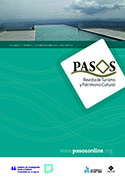Technologies applied to accessibility in protected cultural spaces. Case: Victoria Ocampo Cultural Centre, Mar del Plata
DOI:
https://doi.org/10.25145/j.pasos.2023.21.055Keywords:
Museums, cultural heritage, Accessibility, Technology, visual disabiltyAbstract
Architectural heritage with cultural functions has a hierarchical role in cities as a testimony to history and a promoter of activities for both locals and tourists. Physical, sensory, intellectual and communicational accessibility is a pending issue in most of the properties, particularly in the city of Mar del Plata. Given the need and the challenge of contributing to promoting equal access, use and enjoyment of these spaces, the potential that the incorporation and articulation of new technologies means is recognized. In this sense, a project is under development for the Victoria Ocampo Cultural Center, which takes as its main target the population with visual disabilities. To do this and through the work of an interdisciplinary team, this research-action focuses on the contributions of 3D printing and augmented reality.
Downloads
Publication Facts
Reviewer profiles N/A
Author statements
- Academic society
- PASOS. Revista de Turismo y Patrimonio Cultural
- Publisher
- Instituto Universitario de Investigación Social y Turismo. Universidad de La Laguna (España) - Instituto Universitario da Maia ISMAI (Portugal)
References
Baldasarre, M.I. y Usubiaga, V. (2021) Los patrimonios son políticos o Tilcara como centro del mundo. En Elbirt, A.L. & Muñoz, J.I. (comp.) (2021) Los patrimonios son políticos: patrimonios y políticas culturales en clave de género; p. 13-22; Ciudad Autónoma de Buenos Aires: Ministerio de Cultura de la Nación; RGC Ediciones; Tilcara: Museo Regional de Pintura José Antonio Terry.
Ballesteros, S. (1993). Percepción háptica de objetivos y patrones realzados: una revisión. Psicothema, vol N°5. Pp. 311-321.
Collectiu Punt 6 (2019) Urbanismo feminista: Por una transformación radical de los espacios de vida. Barcelona: Virus Editorial i Distribuidora, SCCL
Fernández Balboa, C. (comp) (2007) La interpretación del patrimonio en la Argentina: estrategias para conservar y comunicar bienes naturales y culturales. Buenos Aires: Administración de Parques Nacionales.
Hernández, S. (2012) La evolución de los museos y su adaptación. Cultura y Desarrollo 8. Pp. 39-44. UNESCO: La Habana
Hernández Sánchez, A. (2020) Maquetas hápticas en 3D para niños con discapacidad visual. Un acercamiento a la ciudad histórica. Bitácora Urbano Territorial, 30 (II). Pp. 47-60.
ICOM (2022) Asamblea General Extraordinaria. Praga. https://icom.museum/es/recursos/normas-y-directrices/definicion-del-museo/
ICOMOS (1999) Carta sobre Gestión del Turismo en los sitios con Patrimonio Significativo
Jiménez- Esquinas, G. (2017) El patrimonio (también) es nuestro. Hacia una crítica patrimonial feminista. En Arrieta Urtizberea, I. (2017) El género en el patrimonio cultural. Pp. 19-48. Bilbao: Universidad del País Vasco
Ley Provincial N° 13.494 (2006) Buenos Aires
Maraña, M. (2015). Patrimonio y Derechos Humanos. Una mirada desde la participación y el género en el trabajo de Naciones Unidas en Patrimonio Cultural. España: UNESCO Etxea - Centro Unesco del País Vasco.
Navarro Gracia, N. y Domínguez Arranz, A. (2019) La inclusión social en el patrimonio a través de la realidad aumentada. Un caso de estudio: La Codera (Huesca). En Foradada Baldellou, C. e Irala-Hortal, P. (coords.) Re_Visiones sobre Arte, patrimonio y tecnología en la era digital. Pp. 19-40. Gobierno de Aragón
OEA (2015) Convención Interamericana sobre la Protección de los Derechos Humanos de las Personas Mayores
ONU (1948) Declaración Universal de los Derechos Humanos
ONU (2007) Convención Internacional de los Derechos de las Personas con Discapacidad
Ordenanza n° 10.075 (1995) Mar del Plata
Peula, J., Torres, F., Urdiales, C. y Sandoval, F. (2008) Aplicación de realidad aumentada para la educación y difusión del patrimonio. Actas del XXIII Simposium Nacional de la Unión Científica Internacional de Radio. Pp. 22-24. Madrid.
Pisoni, G.; Díaz-Rodríguez, N.; Gijlers, H. y Tonolli, L. (2021) Human Centred Artificial Intelligence for Designing Accessible Cultural Heritage. Applied Sciences 2021, 11, 870. https://doi.org/10.3390/app11020870
Slavin, E., & Sanchez, L. M. (2022) Intervenir en el patrimonio arquitectónico hacia su accesibilidad universal: Desafíos en los bienes con funciones culturales de Mar del Plata. En Anales de Investigación en Arquitectura, 12(2). https://doi.org/10.18861/ania.2022.12.2.3249
Downloads
Published
How to Cite
Issue
Section
License
Copyright (c) 2023 Estefania Slavin

This work is licensed under a Creative Commons Attribution-NonCommercial-NoDerivatives 4.0 International License.
I confirm that the work is original (of my/our authorship), and that it will not be submitted to other journals or publications until the final resolution of the review process in PASOS, RTPC.
I authorize the publication of my work by PASOS, PSTN of free and open access in any of the formats that I deem appropriate, for an indefinite period of time and as a non-remunerated collaboration.
Likewise, the author(s) understands that the published work may be linked or deposited on any server or included in other publications (republication), provided that the new place and/or new edition references the original publication and acknowledges the authorship and copyright ownership of PASOS RTPC publications.
Authors understand that a plagiarism-self-plagiarism check will be performed, and the article may be removed at any time from the editorial flow.










